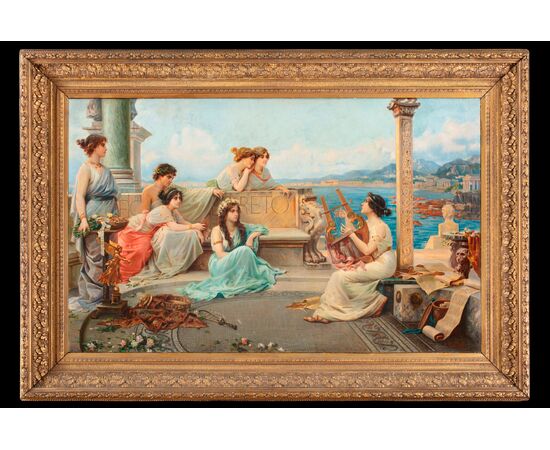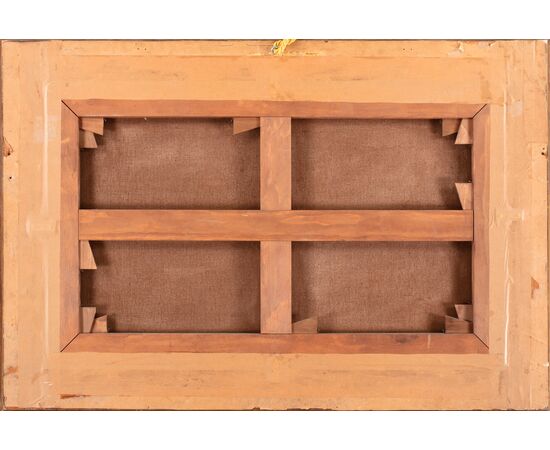Painting by Massimo Gallelli (Cremona 1863-San Remo 1956), The Lyre Player
MASSIMO GALLELLI (1863-1956), The Lyre Player, oil on canvas, 62x102 cm, signed “M. Gallelli” lower right.
The painting depicts a classic genre scene with female and one male figure in a moment of conviviality: one of the young women is performing with the lyre, intoning songs and poems, while the other maidens and the young man, perhaps another poet, listen to her. The scene is set in an ideal open space, a terrace overlooking the sea, with the coastal landscape in the background. The setting of the scene is meticulously reconstructed as if it were the terrace of an ancient Roman villa.
The female figures are depicted with the characteristic ribbons in their hair or a wreath of flowers, in the case of the figure in the center, while the young man wears a laurel wreath; they are seated or standing by a marble seat, on whose back words are engraved, taking inspiration from the engravings on the backs of the seats of ancient theaters. The flooring is decorated with a polychrome mosaic, just like that of a Roman domus. Other details skillfully included in the setting are the musical instruments on the ground, a sistrum and a tambourine, and the rolls of papyrus next to the lyre player.
Gallelli's hand lends a particular luminosity to the painting and a great richness of color.
The painting is a beautiful example of Neopompeian painting that flourished in the second half of the 19th century as a result of the rediscovery and study of ancient Pompeii through important archaeological excavations, as well as from the general revival of classical culture in the 19th century. Artists sensitive to the historical genre were inspired by the environments found with the excavations and the rediscovered wall decorations, in addition to the literary and historical knowledge already acquired. The result of the paintings was a reinterpretation of antiquity by the artists, which in many cases was an aestheticizing vision of ancient subjects resulting from their imagination.
BIOGRAPHY
Massimo Gallelli was born in December 1863 in Cremona. He received his artistic training at the Brera Academy of Fine Arts, under the teaching of Bartolomeo Giuliano. He later won the Ferrari competition, which allowed him to complete his training with a scholarship in Rome. Here he was able to work with Cesare Maccari, with whom he created several frescoes in the Roman area.
Gallelli began to exhibit his works at Roman exhibitions and then continued at the Venice Biennials and other Italian exhibitions.
The genre of the works he produced were landscapes, allegorical and historical scenes, and especially portraits, particularly female ones. His style was characterized by a delicate and elegant touch.
During his stay in Rome, he also became director and teacher at the School of Art in Velletri, until 1896. After that, he moved first to Florence and then to France. Briefly to Paris and then to Nice, which became his new home. Here he won a competition for the fresco decoration of the Casino de Monte Carlo. He created several allegorical works: for example, Tea and Coffee and Smoke and Opium, La joie de l’eau for the spa salon and finally also worked on the decoration of the domes of the Sporting Club.
In Nice he also held the position of vice president of the Academy of Painting and Sculpture from 1910 to 1923.
The following year he returned to Italy, where he settled in San Remo, but also returned to work on the French Riviera. He continued to execute portraits, which were widely appreciated, sacred and allegorical paintings.
He died in San Remo in 1956.




